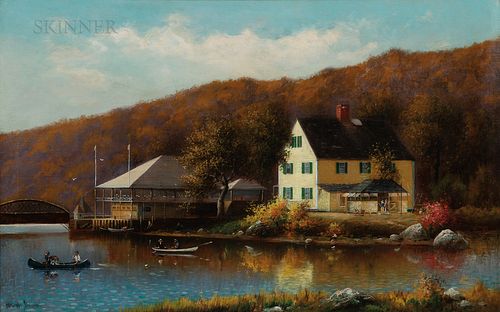W. Warren Brown (American, active c. 1887), The Golden Spur Inn, Lyme, Connecticut
Lot 12
About Seller
Bonhams Skinner
274 Cedar Hill Street
Marlborough, MA 01752
United States
Founded over four decades ago, Bonhams Skinner offers more than 60 auctions annually. Bonhams Skinner auctions reach an international audience and showcase the unique, rare, and beautiful in dozens of categories, including the fine and decorative arts, jewelry, modern design, musical instruments, sc...Read more
Estimate:
$1,800 - $2,200
Absentee vs Live bid
Two ways to bid:
- Leave a max absentee bid and the platform will bid on your behalf up to your maximum bid during the live auction.
- Bid live during the auction and your bids will be submitted real-time to the auctioneer.
Bid Increments
| Price | Bid Increment |
|---|---|
| $0 | $10 |
| $100 | $25 |
| $500 | $50 |
| $1,000 | $100 |
| $3,000 | $250 |
| $5,000 | $500 |
| $10,000 | $1,000 |
| $30,000 | $2,500 |
| $50,000 | $5,000 |
| $100,000 | $10,000 |
| $300,000 | $25,000 |
| $500,000 | $50,000 |
| $1,000,000 | $100,000 |
About Auction
By Bonhams Skinner
Jan 28, 2022
Set Reminder
2022-01-28 10:00:00
2022-01-28 10:00:00
America/New_York
Bidsquare
Bidsquare : American Works of Art
https://www.bidsquare.com/auctions/skinner/american-works-of-art-8710
Join us in Marlborough on Friday, January 28th at 10AM for a live auction of American Works of Art, including painting, sculpture, and works on paper. Bonhams Skinner bidsquare@bonhamsskinner.com
Join us in Marlborough on Friday, January 28th at 10AM for a live auction of American Works of Art, including painting, sculpture, and works on paper. Bonhams Skinner bidsquare@bonhamsskinner.com
- Lot Description
W. Warren Brown (American, active c. 1887)
The Golden Spur Inn, Lyme, Connecticut
Signed "W... Brown" l.l., location identified in a typed description affixed to the frame backing.
Oil on canvas, 24 x 38 in. (61.0 x 96.5 cm), framed.
Condition: Strip lined, retouch primarily to the sky and beneath the bridge l.l., minor canvas rippling to corners.
Provenance: Ex-collection of Professor Benjamin Attmore Hewitt, Dean, Mitchell College, New London, Connecticut, and co-author of The Work of Many Hands: Card Tables in Federal America, 1790-1820.
N.B. The buildings depicted here are The Golden Spur Inn and Pavilion on the Niantic River in East Lyme, Connecticut, c. 1905. The view is painted from Harvest Point on the Waterford side of the river looking south.
The Inn has an interesting history. Located on the Boston Post Road in East Lyme, it was built in the late 18th century as a tavern. Entrepreneur Walter R. Dennison of Groton, Connecticut, acquired the Inn in 1905 as he was constructing the New London and East Lyme Street Railway. To boost ridership for his new trolley line, he also built the Golden Spur Amusement Park at the headwaters of the Niantic River. Dennison added the Golden Spur Pavilion beside the Inn where many festivities were held and, below it, a boat house with boats and canoes for rent. Dennison brought in outside attractions to continue to grow attendance. However, by 1925 with the rise of the automobile, the trolley line met its demise. The park closed when the Pavilion burned in 1929, but the Tavern may still be seen on the Boston Post Road, East Lyme.Condition
Condition: Framed dimensions are 29 1/2 x 43 1/2 x 1 3/4 inches.
Frame with a label from Brater's Art and Frame Shop, New London, Connecticut, which was owned and operated by the artist Gershon Camassar (1908-1995) with his brother Abe for over forty years.
Any condition statement is given as a courtesy to a client, is only an opinion and should not be treated as a statement of fact. Skinner Inc. shall have no responsibility for any error or omission. The absence of a condition statement does not imply that the lot is in perfect condition or completely free from wear and tear, imperfections or the effects of aging. - Shipping Info
-
Please visit http://www.skinnerinc.com/services/payment-and-shipping/ for information regarding the collection of items purchased at auction.
-
- Buyer's Premium



 EUR
EUR CAD
CAD AUD
AUD GBP
GBP MXN
MXN HKD
HKD CNY
CNY MYR
MYR SEK
SEK SGD
SGD CHF
CHF THB
THB














